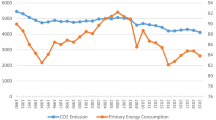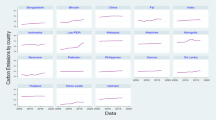Abstract
This study examines the short-run and long-run asymmetric effects of clean energy consumption on carbon emission in Pakistan, over the annual time period 1975–2018, by using a non-linear ARDL approach. The findings of the study confirm the existence of asymmetries, in the nexus between the clean energy consumption and carbon emission in the short and long run. The findings of non-linear model confirm that carbon emission responded contrary to positive shocks of energy variables as compared with their negative shocks. Asymmetric findings recommend that positive and negative shocks of the alternative and nuclear energy and combustible and waste energy have affected differently. Although, short- and long-run results suggest an insignificant positive and negative relationship between electric power consumption and carbon emissions. Therefore, more taxation of non-renewable energy and clean energy supports are suggested for the Pakistan economy. We concluded that Pakistan has potential in clean energy which will improve environmental quality in the near future.


Similar content being viewed by others
References
Adewuyi AO, Awodumi OB (2017) Biomass energy consumption, economic growth and carbon emissions: fresh evidence from West Africa using a simultaneous equation model. Energy 119:453–471
Ahmed K, Ahmed S (2018) A predictive analysis of CO 2 emissions, environmental policy stringency, and economic growth in China. Environ Sci Pollut Res 25(16):16091–16100
Ahmed K, Ozturk I (2018) What new technology means for the energy demand in China? A sustainable development perspective. Environ Sci Pollut Res 25(29):29766–29771
Ahmed K, Ozturk I, Ghumro IA, Mukesh P (2019) Effect of trade on ecological quality: a case of D-8 countries. Environ Sci Pollut Res 26(35):35935–35944
Al-Mulali U (2014) Investigating the impact of nuclear energy consumption on GDP growth and CO2 emission: a panel data analysis. Prog Nucl Energ 73:172–178
Apergis N (2014) Asymmetric real exchange rate pass-through and poverty in China: evidence from a nonlinear model. Appl Econ Lett 22(12):951–954
Apergis N, Payne JE (2012) Renewable and non-renewable energy consumption-growth nexus: evidence from a panel error correction model. Energy Econ 34(3):733–738
Apergis N, Payne JE (2014) Renewable energy, output, CO2 emissions, and fossil fuel prices in Central America: evidence from a nonlinear panel smooth transition vector error correction model. Energy Econ 42:226–232
Apergis N, Payne JE, Menyah K, Wolde-Rufael Y (2010) On the causal dynamics between emissions, nuclear energy, renewable energy, and economic growth. Ecol Econ 69(11):2255–2260
Awodumi OB, Adewuyi AO (2020) The role of non-renewable energy consumption in economic growth and carbon emission: evidence from oil producing economies in Africa. Energy Strateg Rev 27:100434–100443
Baek J (2015) A panel cointegration analysis of CO2 emissions, nuclear energy and income in major nuclear generating countries. Appl Energy 145:133–138
Baek J, Pride D (2014) On the income–nuclear energy–CO2 emissions nexus revisited. Energy Econ 43:6–10
Baležentis T, Streimikiene D, Zhang T, Liobikiene G (2019) The role of bioenergy in greenhouse gas emission reduction in EU countries: an environmental Kuznets curve modelling. Resour Conserv Recy 142:225–231
Bhattacharya M, Paramati SR, Ozturk I, Bhattacharya S (2016) The effect of renewable energy consumption on economic growth: evidence from top 38 countries. Appl Energy 162:733–741
Bhattacharya M, Churchill SA, Paramati SR (2017) The dynamic impact of renewable energy and institutions on economic output and CO2 emissions across regions. Renew Energy 111:157–167
Bilgili F, Koçak E, Bulut Ü (2016a) The dynamic impact of renewable energy consumption on CO2 emissions: a revisited environmental Kuznets curve approach. Renew Sust Energ Rev 54:838–845
Bilgili F, Öztürk İ, Koçak E, Bulut Ü, Pamuk Y, Muğaloğlu E, Bağlıtaş HH (2016b) The influence of biomass energy consumption on CO2 emissions: a wavelet coherence approach. Environ Sci Pollut Res 23(19):19043–19061
Cosmas NC, Chitedze I, Mourad KA (2019) An econometric analysis of the macroeconomic determinants of carbon dioxide emissions in Nigeria. Sci Total Environ 675:313–324
Danish, Wang Z (2019) Does biomass energy consumption help to control environmental pollution? Evidence from BRICS countries. Sci Total Environ 670:1075–1083
Danish, Zhang B, Wang B, Wang Z (2017) Role of renewable energy and non-renewable energy consumption on EKC: evidence from Pakistan. J Clean Prod 156:855–864
Dogan E, Inglesi-Lotz R (2017) Analyzing the effects of real income and biomass energy consumption on carbon dioxide (CO2) emissions: empirical evidence from the panel of biomass-consuming countries. Energy 138:721–727
Dogan E, Seker F (2016) Determinants of CO2 emissions in the European Union: the role of renewable and non-renewable energy. Renew Energy 94:429–439
Dong K, Sun R, Hochman G (2017) Do natural gas and renewable energy consumption lead to less CO2 emission? Empirical evidence from a panel of BRICS countries. Energy 141:1466–1478
Dong K, Sun R, Dong X (2018) CO2 emissions, natural gas and renewables, economic growth: assessing the evidence from China. Sci Total Environ 640:293–302
Georgescu M, Lobell DB, Field CB (2011) Direct climate effects of perennial bioenergy crops in the United States. Proc Natl Acad Sci 108(11):4307–4312
Hydrocarbon Development Institute of Pakistan (2018) Pakistan energy yearbook 2018. Hydrocarbon Development Institute of Pakistan, Ministry of Petroleum and Natural Resources, Government of Pakistan, Islamabad
Iwata H, Okada K, Samreth S (2010) Empirical study on the environmental Kuznets curve for CO2 in France: the role of nuclear energy. Energy Policy 38(8):4057–4063
Jaforullah M, King A (2015) Does the use of renewable energy sources mitigate CO2 emissions? A reassessment of the US evidence. Energy Econ 49:711–717
Jebli MB, Youssef SB (2017) The role of renewable energy and agriculture in reducing CO2 emissions: evidence for North Africa countries. Ecol Indic 74:295–301
Jebli MB, Youssef SB, Ozturk I (2016) Testing environmental Kuznets curve hypothesis: the role of renewable and non-renewable energy consumption and trade in OECD countries. Ecol Indic 60:824–831
Karasoy A (2019) Drivers of carbon emissions in Turkey: considering asymmetric impacts. Environ Sci Pollut Res 26(9):9219–9231
Katircioglu ST (2015) The impact of biomass consumption on CO2 emissions: an empirical investigation from Turkey. International Journal of Climate Change Strategies and Management 7(3):348–358
Lin B, Moubarak M (2014) Renewable energy consumption–economic growth nexus for China. Renew Sust Energ Rev 40:111–117
Maji IK (2015) Does clean energy contribute to economic growth? Evidence from Nigeria. Energy Rep 1:145–150
Menyah K, Wolde-Rufael Y (2010) CO2 emissions, nuclear energy, renewable energy and economic growth in the US. Energy Policy 38(6):2911–2915
Narayan PK (2005) The saving and investment nexus for China: evidence from cointegration tests. Appl Econ 37:1979–1990
Ozturk I (2017) Measuring the impact of alternative and nuclear energy consumption, carbon dioxide emissions and oil rents on specific growth factors in the panel of Latin American countries. Prog Nucl Energy 100:71–81
Paramati SR, Mo D, Gupta R (2017) The effects of stock market growth and renewable energy use on CO2 emissions: evidence from G20 countries. Energy Econ 66:360–371
Pesaran MH, Shin Y, Smith RJ (2001) Bounds testing approaches to the analysis of level relationships. J Appl Econ 16(3):289–326
Richmond AK, Kaufmann RK (2006) Is there a turning point in the relationship between income and energy use and/or carbon emissions? Ecol Econ 56(2):176–189
Saidi K, Mbarek MB (2016) Nuclear energy, renewable energy, CO2 emissions, and economic growth for nine developed countries: evidence from panel granger causality tests. Prog Nucl Energy 88:364–374
Sebri M, Ben-Salha O (2014) On the causal dynamics between economic growth, renewable energy consumption, CO2 emissions and trade openness: fresh evidence from BRICS countries. Renew Sust Energ Rev 39:14–23
Shahbaz M, Bhattacharya M, Ahmed K (2015) Growth-globalisation-emissions nexus: the role of population in Australia. Monash Business School Discussion Paper 23(15):1–33
Shahbaz M, Loganathan N, Muzaffar AT, Ahmed K, Jabran MA (2016) How urbanization affects CO2 emissions of STIRPAT model in Malaysia? The application. Renew Sust Energ Rev 57:83–93
Shahbaz M, Solarin SA, Hammoudeh S, Shahzad SJH (2017) Bounds testing approach to analyzing the environment Kuznets curve hypothesis with structural beaks: the role of biomass energy consumption in the United States. Energy Econ 68:548–565
Shahbaz M, Balsalobre D, Shahzad SJH (2018) The influencing factors of CO2 emissions and the role of biomass energy consumption: statistical experience from G-7 countries. Environ Model & Assess 24(2):143–161
Shin Y, Yu B, Greenwood-Nimmo M (2014) Modelling asymmetric cointegration and dynamic multipliers in a nonlinear ARDL framework. In: Festschrift in honor of Peter Schmidt. Springer, New York, pp 281–314
Solarin SA, Al-Mulali U, Gan GGG, Shahbaz M (2018) The impact of biomass energy consumption on pollution: evidence from 80 developed and developing countries. Environ Sci Pollut Res 25(23):22641–22657
Ullah S, Ozturk I, Usman A, Majeed MT, Akhtar P (2020) On the asymmetric effects of premature deindustrialization on CO2 emissions: evidence from Pakistan. Environ Sci Pollut Res:1–11
Zeb R, Salar L, Awan U, Zaman K, Shahbaz M (2014) Causal links between renewable energy, environmental degradation and economic growth in selected SAARC countries: progress towards green economy. Renew Energy 71:123–132
Zoundi Z (2017) CO2 emissions, renewable energy and the environmental Kuznets curve, a panel cointegration approach. Renew Sust Energ Rev 72:1067–1075
Author information
Authors and Affiliations
Corresponding author
Additional information
Responsible editor: Muhammad Shahbaz
Publisher’s note
Springer Nature remains neutral with regard to jurisdictional claims in published maps and institutional affiliations.
Rights and permissions
About this article
Cite this article
Usman, A., Ullah, S., Ozturk, I. et al. Analysis of asymmetries in the nexus among clean energy and environmental quality in Pakistan. Environ Sci Pollut Res 27, 20736–20747 (2020). https://doi.org/10.1007/s11356-020-08372-5
Received:
Accepted:
Published:
Issue Date:
DOI: https://doi.org/10.1007/s11356-020-08372-5




